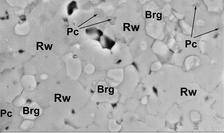A representative back-scattered electron image of the sample recovered from 23.38 GPa and 1700 K, enlarged 3000 times. White, light- and dark-gray grains are bridgmanite (Brg), ringwoodite (Rw) and periclase(Pc), respectively. (Credit: Takayuki Ishii, see supplementary text in the original publication. This figure is licensed under CC BY 4.0.)
Just like graphite turns to diamond under high pressure and temperature, many other minerals transform under extreme conditions in the Earth's interior. Scientists from DESY, worked together with an international group from scientist from the University of Bayreuth and institutions from Japan. They used X-rays from the synchrotron source SPring-8 in Japan to examine a particular solid-state transformation in forsterite, Mg2SiO4 – the magnesium-rich variety of olivine, to confirm a long-standing assumption about the composition of the Earth’s mantle. They published the results in the journal Scientific Reports.
Olivine, otherwise known to jewelers as Peridot, an olive-green gemstone, is believed to be the most abundant mineral in the Earth’s interior. The crystal structure of this mineral is changing under increasing pressures at greater depths in the Earth, marking three transformations. The last transformation, called the post-spinel transition, is the most significant due to the breakdown of the spinel form of olivine into two new high-pressure mineral phases, called bridgmanite and periclase. Assuming that the mantle is dominated by olivine, this transformation at the right temperature and pressure conditions is expected to be responsible for the sharp (<5 km wide) seismic discontinuity observed at ~660 km depth, which separates Earth's upper mantle and lower mantle.
It was not the first attempt to confirm this prediction. Takayuki Ishii, the lead author, emphasizes that “The present study resolved a question of 20 years’ standing discussion, a discrepancy between the post-spinel transition pressure and the 660-km discontinuity depth.” Several previous studies simulated the respective extreme pressure and temperature conditions in a large volume press (LVP) to observe the final transformation of olivine using in situ X-ray diffraction and ex situ ‘quench’ techniques. However, the transformation pressure appeared to be consistently too low (< 22.9 GPa) to match the depth of the 660-km seismic discontinuity (pressure: 23.4 GPa and temperature: > 2170 °C), and these results remained inconclusive until now.
Using the latest high-pressure techniques jointly developed by University of Bayreuth and DESY at the BL04B1 beamline at SPring-8, the researchers discovered that keeping the pressure constant is critical, especially during heating. Due to the thermal relaxation of the high-pressure cell, the pressure medium flows and becomes more compressible, causing a pressure drop in the central sample chamber when the press load is kept constant. By carefully monitoring the sample pressure using X-ray diffraction techniques, the press load was increased accordingly during heating to keep the pressure in the sample chamber constant instead. The post-spinel transition of olivine was therefore observed at this constant pressure. Using this latest technique and an advanced anvil design, a complete agreement was found for the post-spinel transition at pressures equivalent to the 660-km discontinuity. Moreover, the pressure at which the phase transformation took place was determined with a precision of 0.05 GPa, which is unique and impossible to achieve without in situ synchrotron X-ray diffraction techniques.
Determination of pressure and temperature with such high level of precision is paramount to evaluate phase transition boundaries in geochemically complex materials at extreme conditions. According to Takayuki Ishii, “This discovery encourages experimental reinvestigation of every high pressure–temperature phase boundary linked to other seismic discontinuities, which helps in better understanding of the mantle structure.”
Robert Farla, one of the authors from DESY, added: “Similar experiments will be possible at the new PETRA III beamline P61B, which is expecting first beam in 2019.”
Reference: Complete agreement of the post-spinel transition with the 660-km seismic discontinuity; T. Ishii, R. Huang, H. Fei, I. Koemets, Z. Liu, F. Maeda, L. Yuan, L. Wang, D. Druzhbin, T. Yamamoto, S. Bhat, R. Farla, T. Kawazoe, N. Tsujino, E. Kulik, Y. Higo, Y. Tange, T. Katsura; Scientific Reports (2018); DOI: 10.1038/s41598-018-24832-y








